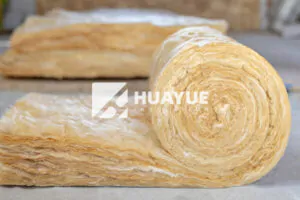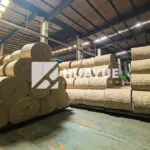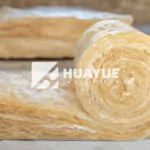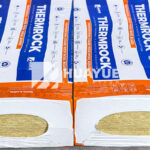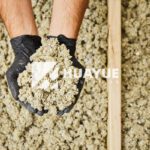Why Is Some Fiberglass Insulation Pink?
Staring at pink insulation and wondering if it’s special? You’re not alone. Many people see this color and question if it means something important for their project’s success.
The pink color in fiberglass insulation is simply a dye added by the manufacturer, Owens Corning, for branding purposes. The color itself does not change the insulation’s performance, R-value, or effectiveness. It’s a marketing tool to make their product instantly recognizable.

I’ve been in the insulation business for over three decades, since we started HUAYUE Group back in 1998. In that time, I’ve seen materials of all shapes, sizes, and even colors. A common question I get from customers, from big industrial plant engineers to homeowners, is about the color. They want to know if pink is better, or if yellow or white insulation is somehow different. It’s a great question, and understanding the answer helps demystify the product. Let’s break down why you see different colors and what really matters when you choose insulation.
Does the color mean it’s a specific type of insulation?
Are you worried the color of your insulation locks you into a certain quality or type? It’s a common concern, but the color is more about branding than performance.
No, the color of fiberglass insulation does not indicate a specific type or performance level. Manufacturers use different colors like pink, yellow, white, or green primarily to distinguish their brand from competitors. The performance is determined by its R-value, not its color.

When we first started producing our own glass wool at HUAYUE, one of the early decisions was about its final look. The natural color of fiberglass insulation is actually an off-white or yellowish-brown. The colors you see on the market are dyes added during manufacturing. Think of it like the color of your car; a red car isn’t faster than a blue one. The engine, or in this case the R-value, determines performance. Owens Corning famously trademarked the color pink for their insulation in 1987, making it a powerful branding tool. They even use the Pink Panther as their mascot. Other major manufacturers chose their own colors. For example, Johns Manville often uses a yellow or white color, and Knauf Insulation is typically brown. Our focus has always been on the quality of the glass wool fibers and the manufacturing process, not the dye we add. The color is just a signpost for the brand, nothing more.
Does the dye affect the insulation’s performance or safety?
Is it possible the dye added to insulation could harm its effectiveness? People rightly wonder if adding chemicals for color might compromise the product’s safety or insulating power.
The dye used in fiberglass insulation is non-toxic and added in very small amounts. It has no measurable impact on the insulation’s thermal performance (R-value), fire resistance, or moisture-wicking properties. The material’s quality comes from its composition and density, not its color.

As a manufacturer with certifications like ISO 9001 and CE, we scrutinize every component that goes into our products, including any dyes. The dyes used are specifically chosen to be inert. This means they don’t react with the glass fibers or the binder that holds them together. They also don’t affect the way the insulation traps air, which is the key to how it works. The millions of tiny air pockets trapped between the glass fibers are what slow the transfer of heat. The dye is purely cosmetic.
Here’s a simple breakdown of what actually determines performance:
| Performance Factor | What Matters | What Doesn’t Matter |
|---|---|---|
| Thermal Resistance | Fiber density, thickness, and quality of manufacturing. | The color of the dye. |
| Fire Safety | The inherent non-combustible nature of glass fibers. | The color of the dye. |
| Moisture Resistance | The binder used and whether it has moisture-repellent additives. | The color of the dye. |
| Durability | The quality and length of the glass fibers. | The color of the dye. |
We test our products rigorously to ensure they meet global standards. The dye is just part of the recipe, like a drop of food coloring in a cake. It changes the appearance but not the substance or quality.
Should I choose an insulation brand based on its color?
Are you trying to decide on an insulation product? It’s easy to get caught up in the visual differences, but that can lead you away from what’s truly important.
You should never choose insulation based on its color. Instead, focus on the R-value required for your climate and application, the product’s certifications (like Greenguard or ISO), and the manufacturer’s reputation. The color is simply marketing.

I often speak with engineers like Hans in Germany, who manage massive industrial tank facilities. When they evaluate our foam glass or rock wool, they are laser-focused on technical specifications: thermal conductivity, compressive strength, and resistance to corrosion under insulation (CUI). They would never make a multi-million dollar decision based on whether the material was black or grey. The same logic applies to fiberglass insulation for your home or building. Your decision should be based on data, not dye. First, determine the necessary R-value for your walls, attic, or floors. This is the most critical number. Then, look at the quality of the product. Is it from a reputable manufacturer with strong quality control, like our ISO-certified facilities? Does it have good reviews? Is the price competitive for the performance it offers? Choosing pink because you recognize the Pink Panther is exactly what the marketing team wants, but it may not get you the best value or performance for your specific needs.
Conclusion
Insulation color is for branding, not performance. Always choose insulation based on the required R-value, quality, and suitability for your project, not the color of the dye.
You may also be interested in:
Ready to Get Started?
Get in touch with our experts for personalized solutions tailored to your needs.
Get Free QuoteLatest Articles
Let's Work Together
Ready to take your business to the next level? Get in touch with our team of experts and let's discuss how we can help you achieve your goals.
Get Free Solutions
